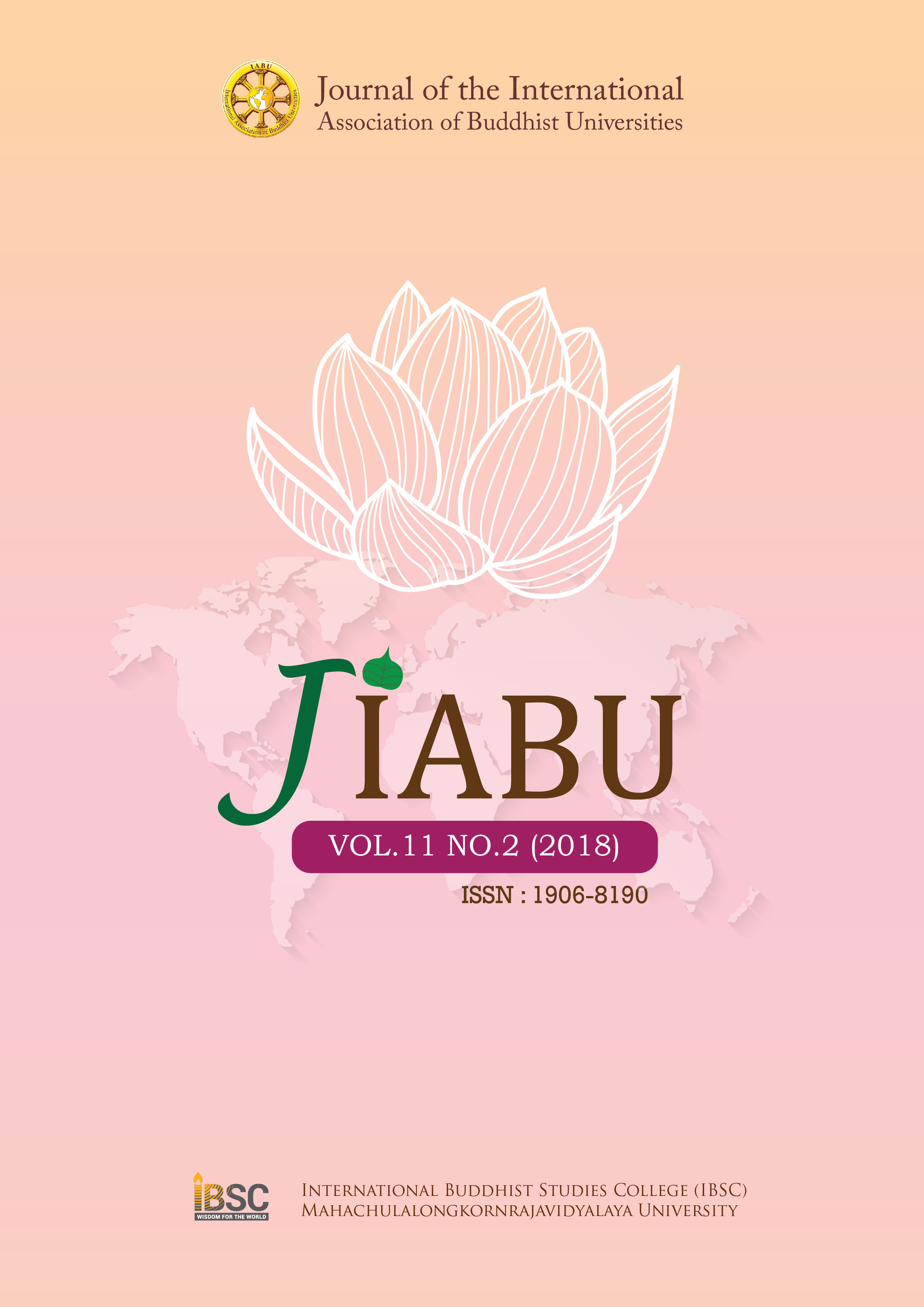The Doctrine of Buddha-Nature in Mahayana Buddhism
Main Article Content
Abstract
The term Buddha-nature, which is a translation of a Sanskrit term “Buddhadhatu”,
refers to one of the most important concepts of Mahayana Buddhism. First texts that mention
the Buddha-nature were composed around 4th century C.E. In general terms, this concept
states that all sentient beings possess the nature of the Buddha and can attain Buddhahood.
However, according to some Buddhist scholars, the idea that sentient beings possess something
permanent seems to contradict the Buddha’s teaching of non-self (anatta), which is, in turn, one
of the most important teachings of early Buddhism. This is most probably the reason why the
doctrine of Buddha-nature has been a source of debate. The author suggests that rejection of
this concept as “non-Buddhist” is rooted in a misunderstanding about the Buddha-nature and
makes an attempt to reflect and analyze some critical perspectives on the Buddha-nature to
examine whether their arguments are valid. This will be followed by a note on the teaching
of non-self and its compatibility with the doctrine of Buddha-nature.
Article Details
Views and opinions expressed in the articles published by The Journal of the International Association of Buddhist Universities (JIABU), are of responsibility by such authors but not the editors and do not necessarily reflect those of the editors.
References
Alayavijnana, Delhi, Motilal Banarsidass Publishers.
Collins (1982), Selfl ess Persons: Imagery and Thought in Theravada Buddhism, Cambridge:
Cambridge University Press.
Conze, E. (2014), Buddhist Texts through the Ages, One World Publications.
Gregory, Peter (1997), “Is Critical Buddhism Really Critical?” Pruning the Bodhi Tree:
The Storm over Critical Buddhism, Edited by Jamie Hubbard & Paul L. Swanson
Honolulu: University of Hawai’i Press
Groner, Paul. “The Lotus Sutra and Saicho’s Interpretation of the Realization of Buddhahood
with This Very Body,” The Lotus Sutra in Japanese Culture. Ed. George J. Tanabe,
Jr. and Willa Jane Tanabe. Honolulu: University of Hawai’i Press, 1989. Print.
Grosnick, William (1981), “No origination and Nirvana in the early Tathagatagarbha Literature,”
Journal of the International Association of Buddhist Studies, Vol.4, Norik
Grosnick, William (1995), “The Tathagatagarbha-sutra,” Ed. Donald Lopez Jr., Buddhism
in Practice, Princeton, Oxford: Princeton University Press.
Hakeda, Yoshito S. (1967), The Awakening of Faith: Attributed to Asvaghosha, Columbia:
Columbia University Press.
Harvey, Peter (1995) The Selfl ess Mind: Personality, Consciousness and Nirvana in Early
Buddhism, Surrey: Curzon.
Harvey, Peter (1990) An Introduction to Buddhism: Teachings, History and Practices,
Cambridge: Cambridge University Press.
Hookham (1992), “The Practical Implications of the Doctrine of Buddha-Nature,” The
Buddhist Forum, vol. 2, ed. Tadeusz Skorupski, Delhi, Heritage Publishers.
Hubbard, Jamie & Paul L. Swanson (1997), Pruning the Bodhi Tree: The Storm over Critical
Buddhism, Honolulu: University of Hawai Press.
King, Richard (1995), Early Advaita Vedanta and Buddhism: The Mahayana Context of the
Gaudapadiya-Karika, New York: State University of New York Press.
King, Sallie Behn (1991), Buddha Nature, New York, Albany, State University of New York
Press.
King, Sallie Behn (1997), “The Doctrine of Buddha-Nature is Impeccably Buddhist,”
Pruning the Bodhi Tree: The Storm Over Critical Buddhism, Honolulu, University
of Hawaii Press
Lai, Whalen (1977), “Chinese Buddhist Causation Theories: An analysis of the Sinitic
Mahayana Understanding of Pratityasamutpada,” Philosophy East and West, vol.
27
Matsumoto, Shiro (1997), “The Doctrine of Tathagata-garbha Is Not Buddhist,” Pruning the
Bodhi Tree: The Storm Over Critical Buddhism^ Honolulu, University of Hawaii
Press
Ng, Yu-kwan (1993), T’ien-t’ai Buddhism and Early Madhyamika, Honolulu: Tendai Institute
of Hawaii Buddhist Studies program, University of Hawaii.
Obermiller, E. (1931), Ratnogotravibhaga-sastra, otherwise known as the Uttaratantra of
Maitreya.
Ruegg, David Seyfort (1989), Buddha-nature, Mind and the Problem of Gradualism in a
Comparative Perspective: On the Transmission and Reception of Buddhism in Indian
and Tibet, Cambridge, School of Oriental and African Studies.
Ruegg, David Seyfort (1969), La Theorie du Tathagatagarbha et du Gotra: Etudes sur la
Soterologie et la Gnoseologie du Buddhisme, Publications de TEcole Francaise d’
Extrene- Orient, vol. 70, Paris: Ecole Francaise d’Extreme-Orient.
Swanson, Paul (1997), “Why They Say Zen Is Not Buddhism,” Pruning the Bodhi Tree:
The Storm over Critical Buddhism, Edited by Jamie Hubbard & Paul L. Swanson
Honolulu: University of Hawai’i Press
Takasaki, Jikido (1966), “Dharmata, Dharmadhatu, Dharmakaya and Buddhadhatu - Structure
of the Ultimate Value in Mahayana Buddhism,” IBK 14 (March)
Takasaki, Jikido (1966), A Study of the Ratnogotravibhaga (Uttaratantra): Being a Treatise
of the Tathagatagarbha Theory of Mahayana Buddhism, Rome: Instituto Itahano per
il Medio ed Estremo Oriente.
Todd, Warren Lee (2013), The Ethics of Sankara and Santideva: A Selfless Response to an
Illusory World, Ashgate Publishing Company.
Verdu, Alfonso (1974), Dialectical Aspects in Buddhist Thought: Studies in Sino-Japanese
Mahayana Idealism, International Studies, East Asian Series, no. 8, n.p: Center for
East Asian Studies, the University of Kansas.
Victoria, Brian Daizen (1997), Zen at War, New York: Weatherhill.
Lai, Whalen (1977), “Chinese Buddhist Causation Theories: An analysis of the Sinitic
Mahayana Understanding of Pratityasamutpada,” Philosophy East and West, vol.
27
Wayman, A and Wayman, H. (1974), The Lion’s Roar of Queen Srlmala: A Buddhist Scripture
on the Tathagatagarbha Theory, New York and London: Columbia University
Press.
Williams, Paul (1989), Mahayana Buddhism: The Doctrinal Foundations, 2nd Ed. London,
New York: Routledge.
Zimmermann, M. (1999), “The Tathagatagarbha Sutra: Its Basic Structure and relation to the
Lotus Sutra,” Annual Report of the International Research Institute for Advanced
Buddhology at the Soka University for the Academic Year 1999, Tokyo: The
International Research Institute for Advanced Buddhology
Zimmermann, M. (2002), A Buddha Within The Tathagatagarbha Sutra - The Earliest
Exposition of the Buddha-Nature Teaching in India, Bibliotheca Philologica et
Philosophica Buddhica VI, Tokyo: The International Research Institute for Advanced
Buddhology, Soka University.


